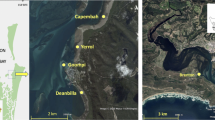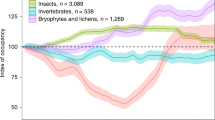Abstract
A multi-scale study of patterns of biodiversity of the fauna of the upper basin of the Kongsfjord, Svalbard (78°55′N, 11°56′E) revealed that there were low rates of species turnover at distances in excess of 2 km. Where patterns within the assemblage were detected, they were largely the result of changing patterns of dominance within a restricted species pool of, for the most part, small-bodied animals. There are relatively few hierarchical studies of species turnover at the scale we have reported and all report different spatial relationships between faunal similarity and separation of the samples. It is strongly recommended that comparative measures of species turnover, estimates of the size of species pools, or comparative estimates of species diversity should include information on the spatial distribution, relative to habitat patchiness, of the samples considered.




Similar content being viewed by others
References
Blake JA (1993) Life history analysis of five dominant infaunal polychaete species from the continental slope off north Carolina. J Mar Biol Assoc UK 73:123–141
Buchanan JB (1993) Evidence of benthic pelagic coupling at a station off the Northumberland coast. J Exp Mar Biol Ecol 172:1–10
Chao A (1987) Estimating the population size for capture-recapture data with unequal catchability. Biometrics 43:783–791
Clarke KR (1993) Non parametric multivariate analyses of changes in community structure. Aust J Ecol 16:117–143
Clarke KR, Green RH (1988) Statistical design and analysis for a biological effects study. Mar Ecol Prog Ser 46:213–226
Clarke KR, Warwick RM (1994) Changes in marine communities; an approach to statistical analysis and interpretation. Plymouth Marine Laboratory, Plymouth
Craeymeersch JA, Heip CHR, Buijs J (1997) Atlas of North Sea benthic infauna. Based on the 1986 North Sea Benthos Survey. International Council for the Exploration of the Sea (ICES) Coop Res Rep 218:8
Curtis MA (1977) Life cycles and population dynamics of marine benthic polychaetes from the Disko Bay area of West Greenland. Ophelia 16:9–58
Dahle S, Denisenko SG, Denisenki NV, Cochrane SJ (1998) Benthic fauna in the Pechora Sea. Sarsia 83:183–210
Elverhøi A, Lonne O, Seland R (1983) Glaciomarine sedimentation in a modern fjord environment, Spitsbergen. Polar Res 1:127–149
Grassle JF, Maciolek NJ (1992) Deep-sea species richness—regional and local diversity estimates from quantitative bottom samples. Am Nat 139:313–341
Gray JS (2000) The measurement of marine species diversity with an application to the benthic fauna of the Norwegian continental shelf. J Exp Mar Biol Ecol 250:23–49
Gray JS (2002) Species richness in marine soft sediments. Mar Ecol Prog Ser 244:285–297
Holte B, Gulliksen B (1998) Common macrofaunal dominant species in the sediments of some north Norwegian and Svalbard glacial fjords. Polar-Biol 19:375–382
Hop H, Pearson T, Hegseth EN, Kovacs KM, Wiencke C, Kwasniewski S, Eiane K, Mehlum F, Gulliksen B, Wlodarska-Kowalczuk M, Lydersen C, Weslawski JM, Cochrane S, Gabrielsen GW, Leakey RJG, Lønne OJ, Zajaczkowski M, Falk-Petersen S, Kendall M, Wängberg S-Å, Bischof K, Voronkov AY, Kovaltchouk NA, Wiktor J, Poltermann M, Prisco di G, Papucci C, Gerland S (2002) The marine ecosystem of Kongsfjorden, Svalbard. Polar Res 21:167–208
Kendall MA (1996) Are Arctic soft sediment macrobenthic communities impoverished? Polar Biol 16:393–399
Kendall MA, Aschan M (1993) Latitudinal gradients in the structure of macrobenthic communities: a comparison of arctic tropical and temperate sites. J Exp Mar Biol Ecol 172:157–170
Kendall MA, Widdicombe S (1999) Small scale patterns in the structure of macrofaunal assemblages of shallow soft sediment. J Exp Mar Biol Ecol 237:127–140
Olsgard F, Hasle JR (1993) Impact of waste from titanium mining in benthic fauna. J Exp Mar Biol Ecol 172:185–214
Pearson TH, Rosenberg R (1978) Macrobenthic succession in relation to organic enrichment and pollution in the marine environment. Oceanogr Mar Biol Annu Rev 16:229–311
Sanders HL (1968) Marine benthic diversity; a comparative study. Am Nat 102:243–282
Somerfield PJ, Gage JD (2000) Community structure of the benthos in Scottish Sea-lochs. IV. Multivariate spatial pattern. Mar Biol 136:1133–1145
Widdicombe S, Austen MC (1999) Mesocosm investigation into the effects of bioturbation on the diversity and structure of a subtidal macrobenthic community. Mar Ecol Prog Ser 189:181–193
Wilson WH (1991) Sexual reproductive modes in polychaetes; classification and diversity. Bull Mar Sci 48:500–516
Wlodarska M, Weslawski JM, Gromisz SA (1996) Comparison of the macrofaunal community structure and diversity in two arctic glacial bays—a 'cold' one off Franz Josef Land and a 'warm' one off Spitsbergen. Oceanology 38:251–283
Wlodarska-Kowalczuk M, Weslawski JM, Kotwicki L (1998) Spitsbergen glacial bays macrobenthos; a comparative study. Polar Biol 20:66–73
Acknowledgements
The work contained in this paper was funded in part by grants from the European Union's Foundations Large Scale Facility (Ny Aalesund) and from UK DEFRA (project no. AE1113). It was partly funded by the UK Natural Environment Research Council through the Plymouth Marine Laboratory research programme Scaling Biodiversity and the Consequences of Change (SBC). We would like to thank the Polish Institute of Oceanology for providing time aboard RV Oceania, and Slawek Kwasniewski, Piotr Kuklinski and Zosia Legezynska for help in collecting the samples. Bob Clarke advised on the sampling design/data analysis and provided invaluable comments on the manuscript. Maria Wlodarska Kovalcuk also provided valuable comments on various drafts of the manuscript. Magda Blazewicz supplied identities for the tanaids. Thanks also go to Haaken Hop of the Norwegian Polar Institute and Nick Cox of British Antarctic Survey for help in arranging the visit to Svalbard and hospitality while there.
Author information
Authors and Affiliations
Corresponding author
Rights and permissions
About this article
Cite this article
Kendall, M.A., Widdicombe, S. & Weslawski, J.M. A multi-scale study of the biodiversity of the benthic infauna of the high-latitude Kongsfjord, Svalbard. Polar Biol 26, 383–388 (2003). https://doi.org/10.1007/s00300-003-0496-x
Received:
Accepted:
Published:
Issue Date:
DOI: https://doi.org/10.1007/s00300-003-0496-x




